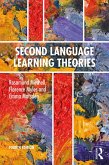Discourse Markers in Second Language French (eBook, ePUB)


Alle Infos zum eBook verschenken

Discourse Markers in Second Language French (eBook, ePUB)
- Format: ePub
- Merkliste
- Auf die Merkliste
- Bewerten Bewerten
- Teilen
- Produkt teilen
- Produkterinnerung
- Produkterinnerung

Hier können Sie sich einloggen

Bitte loggen Sie sich zunächst in Ihr Kundenkonto ein oder registrieren Sie sich bei bücher.de, um das eBook-Abo tolino select nutzen zu können.
This book provides an in-depth look at pragmatic development by second language learners of French through their production of French discourse markers. It showcases a holistic production-focused approach designed to provide a broad picture of learner discourse marker use in French.
The book begins with a comprehensive description of the major theoretical frameworks in discourse marker research. It provides a detailed analysis of prior second language research on discourse markers in several languages and the dominant avenues of inquiry. Additionally, this book engages in a discussion of…mehr
- Geräte: eReader
- mit Kopierschutz
- eBook Hilfe
![Discourse Markers in Second Language French (eBook, PDF) Discourse Markers in Second Language French (eBook, PDF)]() Alisha ReavesDiscourse Markers in Second Language French (eBook, PDF)39,95 €
Alisha ReavesDiscourse Markers in Second Language French (eBook, PDF)39,95 €![Introduction to Instructed Second Language Acquisition (eBook, ePUB) Introduction to Instructed Second Language Acquisition (eBook, ePUB)]() Shawn LoewenIntroduction to Instructed Second Language Acquisition (eBook, ePUB)37,95 €
Shawn LoewenIntroduction to Instructed Second Language Acquisition (eBook, ePUB)37,95 €![Introduction to Instructed Second Language Acquisition (eBook, ePUB) Introduction to Instructed Second Language Acquisition (eBook, ePUB)]() Shawn LoewenIntroduction to Instructed Second Language Acquisition (eBook, ePUB)39,95 €
Shawn LoewenIntroduction to Instructed Second Language Acquisition (eBook, ePUB)39,95 €![Corpus Linguistics and Second Language Acquisition (eBook, ePUB) Corpus Linguistics and Second Language Acquisition (eBook, ePUB)]() Xiaofei LuCorpus Linguistics and Second Language Acquisition (eBook, ePUB)37,95 €
Xiaofei LuCorpus Linguistics and Second Language Acquisition (eBook, ePUB)37,95 €![Second Language Learning Theories (eBook, ePUB) Second Language Learning Theories (eBook, ePUB)]() Rosamond MitchellSecond Language Learning Theories (eBook, ePUB)46,95 €
Rosamond MitchellSecond Language Learning Theories (eBook, ePUB)46,95 €![The Routledge Handbook of Second Language Acquisition and Sociolinguistics (eBook, ePUB) The Routledge Handbook of Second Language Acquisition and Sociolinguistics (eBook, ePUB)]() The Routledge Handbook of Second Language Acquisition and Sociolinguistics (eBook, ePUB)44,95 €
The Routledge Handbook of Second Language Acquisition and Sociolinguistics (eBook, ePUB)44,95 €![Shadowing as a Practice in Second Language Acquisition (eBook, ePUB) Shadowing as a Practice in Second Language Acquisition (eBook, ePUB)]() Shuhei KadotaShadowing as a Practice in Second Language Acquisition (eBook, ePUB)42,95 €
Shuhei KadotaShadowing as a Practice in Second Language Acquisition (eBook, ePUB)42,95 €-
-
-
The book begins with a comprehensive description of the major theoretical frameworks in discourse marker research. It provides a detailed analysis of prior second language research on discourse markers in several languages and the dominant avenues of inquiry. Additionally, this book engages in a discussion of methodology that can serve as a guide for future researchers on the topic. The data presented in this book provide a broad picture of both native speaker and learner production of discourse markers with implications for theoretical and formal understandings of pragmatic meaning.
This book will be of particular interest to scholars in pragmatics for both second language acquisition and formal or theoretical perspectives.
Dieser Download kann aus rechtlichen Gründen nur mit Rechnungsadresse in A, B, BG, CY, CZ, D, DK, EW, E, FIN, F, GR, HR, H, IRL, I, LT, L, LR, M, NL, PL, P, R, S, SLO, SK ausgeliefert werden.
- Produktdetails
- Verlag: Taylor & Francis eBooks
- Seitenzahl: 178
- Erscheinungstermin: 31. März 2023
- Englisch
- ISBN-13: 9781000853131
- Artikelnr.: 67419414
- Verlag: Taylor & Francis eBooks
- Seitenzahl: 178
- Erscheinungstermin: 31. März 2023
- Englisch
- ISBN-13: 9781000853131
- Artikelnr.: 67419414
- Herstellerkennzeichnung Die Herstellerinformationen sind derzeit nicht verfügbar.
List of Tables
List of Figures
Acknowledgements
1. Introduction
1.1 Discourse Markers in French Society
1.2 Discourse Markers in the L2 Classroom
1.3 Learner Challenges in Acquiring Discourse Markers
1.4 Motivations for Studying L2 Discourse Marker Development
1.5 Organization of the Book
1.6 References
2. What are Discourse Markers?
2.1 Terminological Debates
2.2 Key Characteristics of Discourse Markers
2.3 What (for practical purposes) Counts as a Discourse Marker?
2.4 Discourse Markers and Position
2.5 Discourse Marker Combinations
2.6 Defining Discourse Markers for this Study
2.7 References
3. Functions of Common French Discourse Markers
3.1 Introduction
3.2 Alors
3.3 Ben
3.4 Bon
3.5 Donc
3.6 En effet
3.7 En fait
3.8 Enfin
3.9 Hein
3.10 Mais
3.11 Oui
3.12 Parce que
3.13 Puis
3.14 Quoi
3.15 Tu sais
3.16 Voilà
3.17 References
4. What Do We Already Know about L2 Discourse Marker Use?
4.1 Five Conclusions Drawn from L2 Discourse Marker Research to Date
4.2 Can L1 Transfer Explain Learner Discourse Marker Production?
4.3 What Sociolinguistic Variables Affect Discourse Marker Use in the L2?
4.4 What is the Effect of Study Abroad?
4.5 (How) Do Learners Process Discourse Markers that They Hear?
4.6 Can Discourse Markers Be Taught?
4.7 Refocusing on L2 French Discourse Markers
4.8 Conclusion
4.9 References
5. Methodological Questions in L2 Discourse Marker Research
5.1 Introduction
5.2 Contrastive or Interlanguage Analysis?
5.3 Form-to-function or function-to-form?
5.4 The Effects of Tasks and Instruments
5.5 The Current Study
5.6 Conclusion
5.7 References
6. How Do Native Speakers Use Discourse Markers?
6.1 Introduction
6.2 What is the Inventory of Discourse Markers Used by the Native Speakers
of French in this Study?
6.3 What is the Functional Distribution of Discourse Markers for Native
Speakers in this Corpus?
6.4 Syntactic Considerations
6.5 Sociolinguistic Considerations
6.6 Conclusion
6.7 References
7. How Do Learners of French use Discourse Markers?
7.1 Introduction
7.2 What is the Inventory of Discourse Markers used by Learners of French?
7.3 What is the Distribution of DM to function and How Does the Inventory
of DMs and their Functions Change over Time?
7.4 Syntactic Considerations
7.5 Sociolinguistic Considerations
7.6 Conclusion
7.7 References
8. New Insights and Next Steps in L2 Discourse Marker Research
8.1 Introduction
8.2 Primary Findings of this Study
8.3 Other Contributing Factors to L2 Discourse Marker Acquisition
8.4 What can L2 Acquisition Tell us about the Nature of Discourse Markers?
8.5 Methodological and Pedagogical Implications
8.6 References
9. Conclusion
9.1 Concluding Remarks
9.2 Future Directions
9.3 References
10. Appendices
Appendix A - Participant Profiles
Appendix B - Native Speaker Discourse Marker Inventory
Appendix C - Learner Discourse Marker Inventory
References
Index
List of Tables
List of Figures
Acknowledgements
1. Introduction
1.1 Discourse Markers in French Society
1.2 Discourse Markers in the L2 Classroom
1.3 Learner Challenges in Acquiring Discourse Markers
1.4 Motivations for Studying L2 Discourse Marker Development
1.5 Organization of the Book
1.6 References
2. What are Discourse Markers?
2.1 Terminological Debates
2.2 Key Characteristics of Discourse Markers
2.3 What (for practical purposes) Counts as a Discourse Marker?
2.4 Discourse Markers and Position
2.5 Discourse Marker Combinations
2.6 Defining Discourse Markers for this Study
2.7 References
3. Functions of Common French Discourse Markers
3.1 Introduction
3.2 Alors
3.3 Ben
3.4 Bon
3.5 Donc
3.6 En effet
3.7 En fait
3.8 Enfin
3.9 Hein
3.10 Mais
3.11 Oui
3.12 Parce que
3.13 Puis
3.14 Quoi
3.15 Tu sais
3.16 Voilà
3.17 References
4. What Do We Already Know about L2 Discourse Marker Use?
4.1 Five Conclusions Drawn from L2 Discourse Marker Research to Date
4.2 Can L1 Transfer Explain Learner Discourse Marker Production?
4.3 What Sociolinguistic Variables Affect Discourse Marker Use in the L2?
4.4 What is the Effect of Study Abroad?
4.5 (How) Do Learners Process Discourse Markers that They Hear?
4.6 Can Discourse Markers Be Taught?
4.7 Refocusing on L2 French Discourse Markers
4.8 Conclusion
4.9 References
5. Methodological Questions in L2 Discourse Marker Research
5.1 Introduction
5.2 Contrastive or Interlanguage Analysis?
5.3 Form-to-function or function-to-form?
5.4 The Effects of Tasks and Instruments
5.5 The Current Study
5.6 Conclusion
5.7 References
6. How Do Native Speakers Use Discourse Markers?
6.1 Introduction
6.2 What is the Inventory of Discourse Markers Used by the Native Speakers of French in this Study?
6.3 What is the Functional Distribution of Discourse Markers for Native Speakers in this Corpus?
6.4 Syntactic Considerations
6.5 Sociolinguistic Considerations
6.6 Conclusion
6.7 References
7. How Do Learners of French use Discourse Markers?
7.1 Introduction
7.2 What is the Inventory of Discourse Markers used by Learners of French?
7.3 What is the Distribution of DM to function and How Does the Inventory of DMs and their Functions Change over Time?
7.4 Syntactic Considerations
7.5 Sociolinguistic Considerations
7.6 Conclusion
7.7 References
8. New Insights and Next Steps in L2 Discourse Marker Research
8.1 Introduction
8.2 Primary Findings of this Study
8.3 Other Contributing Factors to L2 Discourse Marker Acquisition
8.4 What can L2 Acquisition Tell us about the Nature of Discourse Markers?
8.5 Methodological and Pedagogical Implications
8.6 References
9. Conclusion
9.1 Concluding Remarks
9.2 Future Directions
9.3 References
10. Appendices
Appendix A - Participant Profiles
Appendix B - Native Speaker Discourse Marker Inventory
Appendix C - Learner Discourse Marker Inventory
References
Index
List of Tables
List of Figures
Acknowledgements
1. Introduction
1.1 Discourse Markers in French Society
1.2 Discourse Markers in the L2 Classroom
1.3 Learner Challenges in Acquiring Discourse Markers
1.4 Motivations for Studying L2 Discourse Marker Development
1.5 Organization of the Book
1.6 References
2. What are Discourse Markers?
2.1 Terminological Debates
2.2 Key Characteristics of Discourse Markers
2.3 What (for practical purposes) Counts as a Discourse Marker?
2.4 Discourse Markers and Position
2.5 Discourse Marker Combinations
2.6 Defining Discourse Markers for this Study
2.7 References
3. Functions of Common French Discourse Markers
3.1 Introduction
3.2 Alors
3.3 Ben
3.4 Bon
3.5 Donc
3.6 En effet
3.7 En fait
3.8 Enfin
3.9 Hein
3.10 Mais
3.11 Oui
3.12 Parce que
3.13 Puis
3.14 Quoi
3.15 Tu sais
3.16 Voilà
3.17 References
4. What Do We Already Know about L2 Discourse Marker Use?
4.1 Five Conclusions Drawn from L2 Discourse Marker Research to Date
4.2 Can L1 Transfer Explain Learner Discourse Marker Production?
4.3 What Sociolinguistic Variables Affect Discourse Marker Use in the L2?
4.4 What is the Effect of Study Abroad?
4.5 (How) Do Learners Process Discourse Markers that They Hear?
4.6 Can Discourse Markers Be Taught?
4.7 Refocusing on L2 French Discourse Markers
4.8 Conclusion
4.9 References
5. Methodological Questions in L2 Discourse Marker Research
5.1 Introduction
5.2 Contrastive or Interlanguage Analysis?
5.3 Form-to-function or function-to-form?
5.4 The Effects of Tasks and Instruments
5.5 The Current Study
5.6 Conclusion
5.7 References
6. How Do Native Speakers Use Discourse Markers?
6.1 Introduction
6.2 What is the Inventory of Discourse Markers Used by the Native Speakers
of French in this Study?
6.3 What is the Functional Distribution of Discourse Markers for Native
Speakers in this Corpus?
6.4 Syntactic Considerations
6.5 Sociolinguistic Considerations
6.6 Conclusion
6.7 References
7. How Do Learners of French use Discourse Markers?
7.1 Introduction
7.2 What is the Inventory of Discourse Markers used by Learners of French?
7.3 What is the Distribution of DM to function and How Does the Inventory
of DMs and their Functions Change over Time?
7.4 Syntactic Considerations
7.5 Sociolinguistic Considerations
7.6 Conclusion
7.7 References
8. New Insights and Next Steps in L2 Discourse Marker Research
8.1 Introduction
8.2 Primary Findings of this Study
8.3 Other Contributing Factors to L2 Discourse Marker Acquisition
8.4 What can L2 Acquisition Tell us about the Nature of Discourse Markers?
8.5 Methodological and Pedagogical Implications
8.6 References
9. Conclusion
9.1 Concluding Remarks
9.2 Future Directions
9.3 References
10. Appendices
Appendix A - Participant Profiles
Appendix B - Native Speaker Discourse Marker Inventory
Appendix C - Learner Discourse Marker Inventory
References
Index
List of Tables
List of Figures
Acknowledgements
1. Introduction
1.1 Discourse Markers in French Society
1.2 Discourse Markers in the L2 Classroom
1.3 Learner Challenges in Acquiring Discourse Markers
1.4 Motivations for Studying L2 Discourse Marker Development
1.5 Organization of the Book
1.6 References
2. What are Discourse Markers?
2.1 Terminological Debates
2.2 Key Characteristics of Discourse Markers
2.3 What (for practical purposes) Counts as a Discourse Marker?
2.4 Discourse Markers and Position
2.5 Discourse Marker Combinations
2.6 Defining Discourse Markers for this Study
2.7 References
3. Functions of Common French Discourse Markers
3.1 Introduction
3.2 Alors
3.3 Ben
3.4 Bon
3.5 Donc
3.6 En effet
3.7 En fait
3.8 Enfin
3.9 Hein
3.10 Mais
3.11 Oui
3.12 Parce que
3.13 Puis
3.14 Quoi
3.15 Tu sais
3.16 Voilà
3.17 References
4. What Do We Already Know about L2 Discourse Marker Use?
4.1 Five Conclusions Drawn from L2 Discourse Marker Research to Date
4.2 Can L1 Transfer Explain Learner Discourse Marker Production?
4.3 What Sociolinguistic Variables Affect Discourse Marker Use in the L2?
4.4 What is the Effect of Study Abroad?
4.5 (How) Do Learners Process Discourse Markers that They Hear?
4.6 Can Discourse Markers Be Taught?
4.7 Refocusing on L2 French Discourse Markers
4.8 Conclusion
4.9 References
5. Methodological Questions in L2 Discourse Marker Research
5.1 Introduction
5.2 Contrastive or Interlanguage Analysis?
5.3 Form-to-function or function-to-form?
5.4 The Effects of Tasks and Instruments
5.5 The Current Study
5.6 Conclusion
5.7 References
6. How Do Native Speakers Use Discourse Markers?
6.1 Introduction
6.2 What is the Inventory of Discourse Markers Used by the Native Speakers of French in this Study?
6.3 What is the Functional Distribution of Discourse Markers for Native Speakers in this Corpus?
6.4 Syntactic Considerations
6.5 Sociolinguistic Considerations
6.6 Conclusion
6.7 References
7. How Do Learners of French use Discourse Markers?
7.1 Introduction
7.2 What is the Inventory of Discourse Markers used by Learners of French?
7.3 What is the Distribution of DM to function and How Does the Inventory of DMs and their Functions Change over Time?
7.4 Syntactic Considerations
7.5 Sociolinguistic Considerations
7.6 Conclusion
7.7 References
8. New Insights and Next Steps in L2 Discourse Marker Research
8.1 Introduction
8.2 Primary Findings of this Study
8.3 Other Contributing Factors to L2 Discourse Marker Acquisition
8.4 What can L2 Acquisition Tell us about the Nature of Discourse Markers?
8.5 Methodological and Pedagogical Implications
8.6 References
9. Conclusion
9.1 Concluding Remarks
9.2 Future Directions
9.3 References
10. Appendices
Appendix A - Participant Profiles
Appendix B - Native Speaker Discourse Marker Inventory
Appendix C - Learner Discourse Marker Inventory
References
Index







